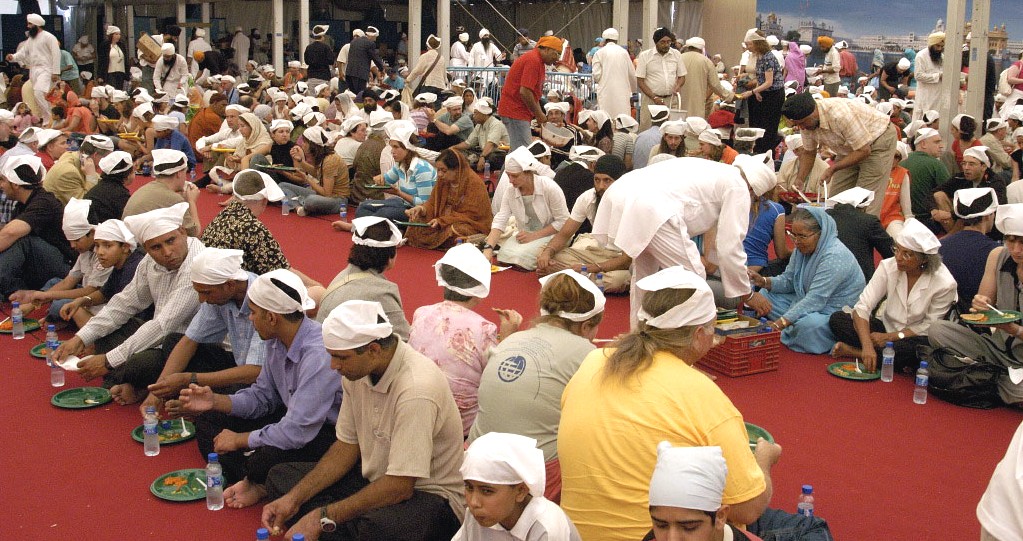The last few years in India have borne witness to an increasing communalization of not only identities and languages but also whole cultures and their customs, including those surrounding food habits and choices. This form of cultural policing has polarized food as an entity by reducing it to a marker of cultural identity that divides and excludes along regional, caste and religious lines and takes away from the cultural significance of partaking of food as a community-oriented and humanity-centred activity. Yet, food has not entirely lost its unifying cultural function. The revival of public protests in recent years has ensured that the spirit of solidarity and resistance that they embody against the communal, divisive forces continues to be embodied in food and the collective partaking of it.
The Shaheen Bagh protests against the CAA-NRC and the protests by farmers against the legislated and the recently repealed Farm bills are instances that testify to the significance of food in the context of the culture of resistance and collective assertion of solidarity. The continuous supply of a variety of food at the sit-in protest sites of Shaheen Bagh, Tikri Border, Singhu Border and Ghazipur Border is, on the one hand symbolically significant, in terms of eating collectively, and on the other hand, an assertion of collective solidarity expressed through the contribution that common people make in ensuring a constant supply of food for the protestors. The whole concept of langar or free community kitchen where everyone sits together to eat irrespective of their caste, religion or class, espoused by Sikhism and upheld during protests further associates food with a sense of equality and solidarity.

Yet, food has not only been politicized and communalized in recent times but has also been used as a means of exclusion and othering. By associating certain foods with particular communities, often marginalized within the discourse of nationalism, the ruling dispensation seeks to further marginalize them and their cultures through means of cultural policing. The ‘otherization’ of certain foods is, in consequence, the otherization of certain cultures and lifestyles. Food then is being used as a means of asserting cultural supremacy by the dominant cultural groups that exercise and enjoy political power.
The most recent instance of this cultural othering is the antagonism against Muslim-owned restaurants in Kerala which calls for a boycott of such restaurants on the false grounds that they spit on their food, after a video of a Muslim man apparently spitting on food was circulated by right-wing groups. The call for ‘spit-free food’ and the preposterous claims of there being a ‘thook jihad’ (spit jihad) brings to the fore the bigotry that has engulfed food cultures. The otherization through food is not just driven by communal hate but also has at its core the ideas of Brahmanical supremacy, caste politics and the desire for economic and political supremacy by marginalizing the cultural minorities both culturally and economically. Last year, in Uttar Pradesh, Muslim vegetable sellers were harassed and stopped from selling vegetables on the false allegations of what infamously came to be known as ‘corona jihad’. Reeking of Islamophobia, the so-called ‘corona jihad’ was based on the preposterous and arbitrary claim that Indian Muslims were purposely spreading coronavirus.
Back in 2019, another aspect of the communalization of food came to the fore. A Hindu customer of Zomato refused to have his food delivered by a Muslim delivery boy simply on the grounds of the latter being a non-Hindu. To gauge the absurdity of the whole situation one also needs to look at the way those in power not just react to such hate but also the way in which they themselves become the instruments through which hate is propagated and communities othered. A BJP leader’s claim that he could identify Bangladeshis from the fact that they eat poha (flattened rice) is not just ludicrous but is rather outrageous. The association of a particular kind of food with a particular section of the society is not as innocent as it may be presented, rather a whole politics of exclusion, stereotyping and othering is at function here. The brutal lynching of Muhammad Akhlaq, in 2015, by a Hindu Mob over rumours that he and his family were consuming beef exposes the collapsed and failed outlook of a society where food choices are no longer a matter of individual choice but rather influenced and shaped by politics of communalization and hate.
The food fascism that is being practiced in India today, with the ruling dispensation exposing the underbelly of its communally-charged, belligerent form of exclusionary nationalism, is a perilous and appalling undertaking. Though the revival of mass agitations and protests in recent times has tried to counter the chauvinism and bigotry of the state by asserting the power of the collective, nonetheless the venom of hate has poisoned food, reducing it merely to a cultural means by which to exclude and control, overshadowing the importance of breaking the bread together!
Hunardeep Kaur is a third year student of English Literature at Lady Shri Ram College for Women, University of Delhi. She is interested in looking at the world through the lens of art, literature and culture. She finds solace in poetry and sunsets.



Thanx for the effort, keep up the good work Great work, I am going to start a small Blog Engine course work using your site I hope you enjoy blogging with the popular BlogEngine.net.Thethoughts you express are really awesome. Hope you will right some more posts.
It’s perfect time to make some plans for the long run and it’s time to be happy. I have read this post and if I could I desire to suggest you some interesting things or suggestions. Maybe you can write subsequent articles regarding this article. I wish to read even more things approximately it!
We’re a group of volunteers and starting a new scheme in our community. Your web site provided us with valuable information to work on. You have done an impressive job and our entire community will be grateful to you.
Thank you, I have just been searching for info about this topic for a while and yours is the best I’ve found out till now. But, what about the bottom line? Are you sure about the source?
I was recommended this blog through my cousin. I am now not certain whether or not this submit is written by way of him as no one else understand such particular about my trouble. You’re amazing! Thank you!
Nice read, I just passed this onto a friend who was doing a little research on that. And he just bought me lunch as I found it for him smile So let me rephrase that: Thanks for lunch!